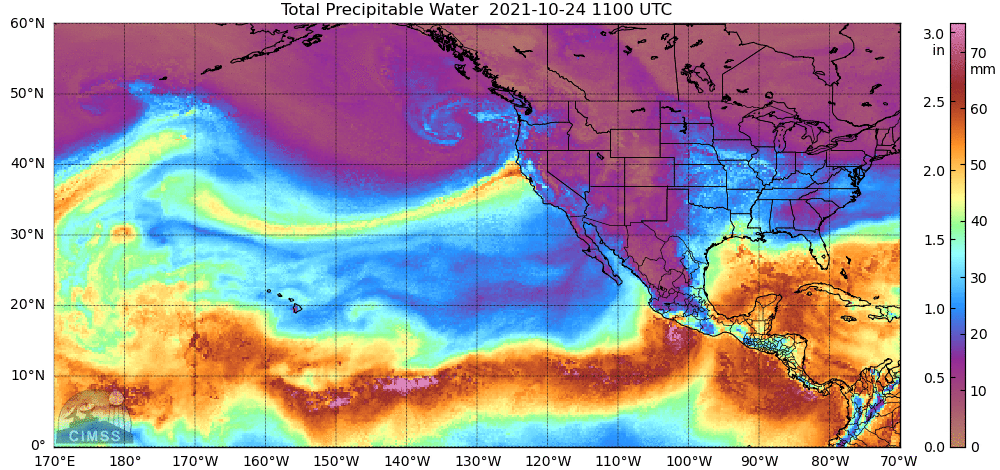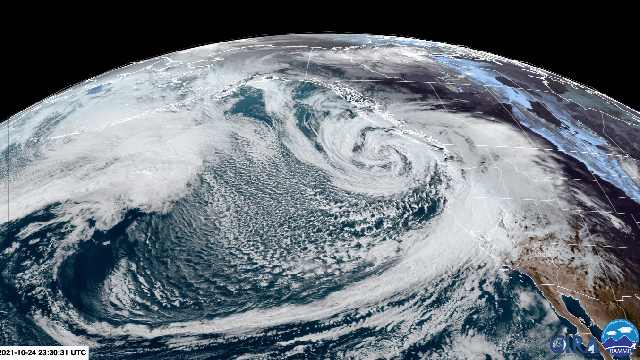The West Coast wet season kicked off with a bang over the weekend. After a series of successively more powerful storms fuelled by an atmospheric river hit the region late last week, the big one arrived with a force on Sunday.
A staggering swirl of clouds parked off the Pacific Northwest coast, sending extreme bands of rain swirling inland. While the storm is still doing damage, it’s already set a major record for the most intense to ever hit this location.
You’d be forgiven for looking at the above satellite image and think a hurricane somehow hooked up from the waters around Baja California and made its way to the Pacific Northwest. While it’s true the storm has a tropical connection, it’s not quite a hurricane, though. Instead, it’s an extratropical cyclone.
While they certainly resemble hurricanes, they have one key difference. Instead of a warm core, extratropical cyclones have a cold one. Nor’easters are a classic example of extratropical cyclones, but these types of storms can form in any ocean basin outside the tropics. This one isn’t just an “average” extratropical cyclone, but one that bombed out.
A bomb cyclone is defined as any storm that sees pressure drop more than 24 millibars in 24 hours. (Lower pressure tends to equate with stronger storms.) This storm doubled that rate of drop. In doing so, it became the strongest storm to ever form in the region off the Northwest coast, according to National Hurricane Centre specialist Philippe Papin. Pressure dropped to a staggering 942 millibars. That’s basically on par with Hurricane Sandy or, to take a more recent example, Hurricane Florence. The storm also had hurricane-force winds and stirred up seas with 45-foot (14-metre) waves.

The storm currently hitting California and other parts of the West Coast is getting a shot of moisture from the tropics. Satellite imagery of total precipitable water, a measure of how much water stands between the atmosphere and the surface, reveals a snap of soggy air stretching from near Hawaii to California. That makes this a near textbook example of a Pineapple Express atmospheric river. (Weather, not weed. Come on, it’s Monday morning here.)
Like a big bong rip of Pineapple Express (now we’re talking about weed), this storm may be too much of a good thing. A rating system put together by the Scripps Institute of Oceanography to rate atmospheric rivers using intensity, location, and duration put this storm as a Category 5. That’s the most extreme rating, and it shows in what’s played out on the ground.
Heavy rain piled up in San Francisco, with Sunday being the fourth-heaviest daily rainfall total in 170 years and the wettest day ever recorded in October. Sacramento set an all-time daily record for any month as well, with more than 5.4 inches (13.7 centimeters) falling on Sunday. Blue Canyon, a small town in the Sierra, picked up 10.4 inches (26.4 centimeters) of rain, which is both a huge total and also an all-time record.
More worryingly, heavy rainfall also fell in areas hit hard by wildfires over the past couple of years. With no vegetation to hold soil in place, the rain caused numerous landslides and debris flows that led to road closures. At least two people died in Seattle metro area after a tree fell on their car.
The heavy rain is also unlikely to end the drought that’s gripped the West. The precipitation deficit is so grave that a single storm, even one as fierce as the bomb cyclone-atmospheric river extravaganza, isn’t enough to pull the region back to normal. These types of wild swings in precipitation are expected due to the climate crisis, which means the West needs to get ready to live with less water and more of it — as this weekend’s storm shows, a lot more.
